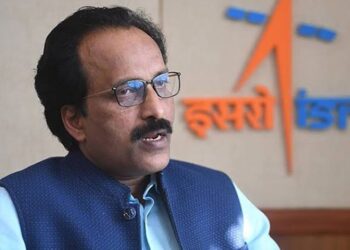The Indian Space Research Organization is gearing up for yet another significant experiment. The nation is once again waiting with bated breath for the launch of Aditya L1, India’s third interplanetary journey to the Sun.
The countdown to the great historic event, which comes on the heels of the successful landing of Chandrayaan 3, has created enormous hopes, and prayers are once again being offered in the hope that this mission, too, would be a great success.
The countdown to the Saturday morning launch of India’s third interplanetary mission, Aditya-L1, will begin at 12.20 p.m. on Friday, according to a senior official with the Indian Space Research Organisation (ISRO).
“The countdown will begin at 12.20 p.m. today (Friday),” said an official to IANS.
On Friday, ahead of the critical launch of the Aditya L1 mission to study the Sun, scientists from the Indian Space Research Organisation (ISRO) sought Lord Venkateswara’s blessings by praying at Tirumala temple.
In the morning, experts from the space agency went to the Sri Venkateswara shrine on Tirumala Hills.
They prayed for the mission’s success, which is set to launch on September 2 at 11.50 a.m. from the Andhra Pradesh spaceport of Sriharikota.
PSLV-C57/Aditya-L1 Mission:
The 23-hour 40-minute countdown leading to the launch at 11:50 Hrs. IST on September 2, 2023, has commended today at 12:10 Hrs.The launch can be watched LIVE
on ISRO Website https://t.co/osrHMk7MZL
Facebook https://t.co/zugXQAYy1y
YouTube…— ISRO (@isro) September 1, 2023
Surprisingly, India reached the Moon on August 23, with its lander safely landing on lunar soil in textbook fashion. Later, the rover descended and began conducting experiments.
The Aditya-L1 — named after the Hindu Sun God — will be launched by the Indian Polar Satellite Launch Vehicle-XL version (PSLV-XL). The rocket will launch on Saturday at 11.50 a.m. from the Sriharikota rocket port in Andhra Pradesh, according to the ISRO.
During the countdown, the rocket will be fuelled with liquid fuel and its systems will be tested.
Aditya-L1 will be sent into low-Earth orbit (LEO) at first. The orbit will thereafter be elliptical. As the spaceship approaches L1, it will leave the Earth’s gravitational Sphere of Influence (SOI).
Aditya-L1’s overall transit time from launch to L1 will be around four months, with a distance of approximately 1.5 million kilometers from Earth.
The Earth-Moon distance is approximately 3,84,000 kilometers.
“A satellite placed in the halo orbit around the L1 point has the major advantage of continuously viewing the Sun without any occultation/eclipses.
This will provide a greater advantage of observing the solar activities and its effect on space weather in real time,” the ISRO said.
According to the ISRO, the spacecraft carries seven payloads to observe the photosphere, chromosphere, and the outermost layers of the Sun (the corona) using electromagnetic and particle and magnetic field detectors.
“Using the special vantage point L1, four payloads directly view the Sun and the remaining three payloads carry out in-situ studies of particles and fields at the Lagrange point L1, thus providing important scientific studies of the propagatory effect of solar dynamics in the interplanetary medium,” it said.
The seven payloads of Aditya-L1 are expected to provide the most critical information to understand the problem of coronal heating, coronal mass ejection, pre-flare and flare activities and their characteristics, dynamics of space weather, particle and field propagation, and other topics, according to the Indian space agency.
The key science objectives of the Aditya-L1 mission, according to the ISRO, are as follows: research of solar upper atmosphere (chromosphere and corona) dynamics, study of chromospheric and coronal heating, physics of partly ionised plasma, and initiation of coronal mass ejections and flares.
It will also monitor the in-situ particle and plasma environment, providing data for research into particle dynamics from the Sun.
Other goals include solar corona physics and its heating mechanism, diagnostics of coronal and coronal loop plasma: temperature, velocity, and density, development, dynamics, and origin of Coronal Mass Ejections (CME), identifying the sequence of processes that occur at multiple layers (chromosphere, base, and extended corona) that eventually leads to solar eruptive events, magnetic field topology and magnetic field measurements in the solar corona, and the drivers for space weather (origin, composition and dynamics of solar wind).
The Indian space agency said that the Sun estimated to be 4.5 billion years old is a hot glowing ball of hydrogen and helium gases and is the source of energy for the solar system. “The gravity of the sun holds all the objects of the solar system together. At the central region of the sun, known as ‘core’, the temperature can reach as high as 15 million degree Celsius,” it said.
At this temperature, a process known as nuclear fusion occurs in the Sun’s core, which powers it. According to the ISRO, the visible surface of the sun, known as the photosphere, is comparatively cool and has a temperature of roughly 5,500 degrees Celsius.
Because the sun is the closest star, it can be researched in greater depth than other stars. According to the ISRO, studying the sun can teach us a lot about stars in our Milky Way as well as those in distant galaxies.
The Sun is an extremely dynamic star that expands well beyond what we can see. It exhibits various eruptive features and emits a massive quantity of energy into the solar system. If such a violent solar event is directed towards the earth, it could cause various types of disturbances in the near earth space environment.
Various spacecraft and communication systems are vulnerable to such disruptions, therefore early notice of such incidents is critical for taking corrective action.
Furthermore, if an astronaut is directly exposed to such explosive occurrences, he or she will be in risk. The sun’s thermal and magnetic phenomena are of tremendous magnitude. As a result, the Sun serves as a good natural laboratory for understanding processes that cannot be investigated directly in the lab.
According to the Indian space agency, all seven payloads carried by Aditya-L1 were produced in-house by several laboratories around the country in close collaboration with it. The Visible Emission Line Coronagraph (VELC) instrument is being developed at the Indian Institute of Astrophysics in Bangalore; the Solar Ultra-violet Imaging Telescope (SUIT) instrument is being developed at the Inter University Centre for Astronomy & Astrophysics in Pune; the Aditya Solar Wind Particle Experiment (ASPEX) at the Physical Research Laboratory in Ahmedabad; the Plasma Analyser Package for Aditya (PAPA) at the Space Physics Laboratory, Vikram Sarabhai Space Centre, Thiruvananthapuram; Solar Low Energy X-ray Spectrometer (SoLEXS) and High Energy L1 Orbiting X-ray Spectrometer (HEL1OS) payloads at U R Rao Satellite Centre, Bangalore and the Magnetometer at the Laboratory for Electro Optics Systems, Bengaluru.
Source:IANS








 Finance
Finance







